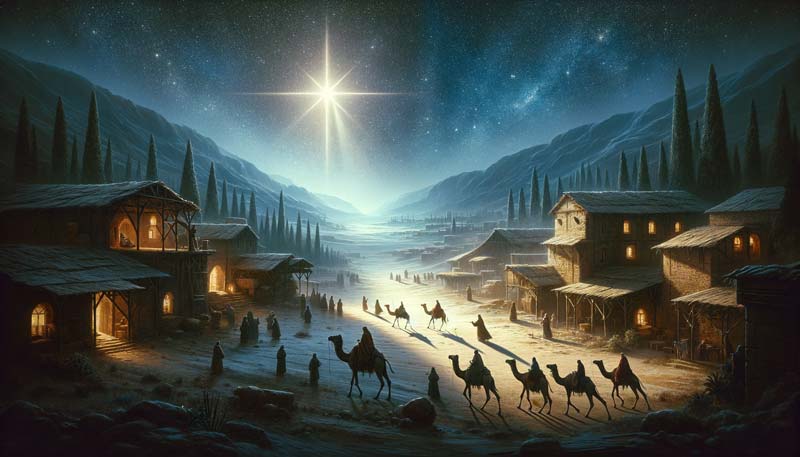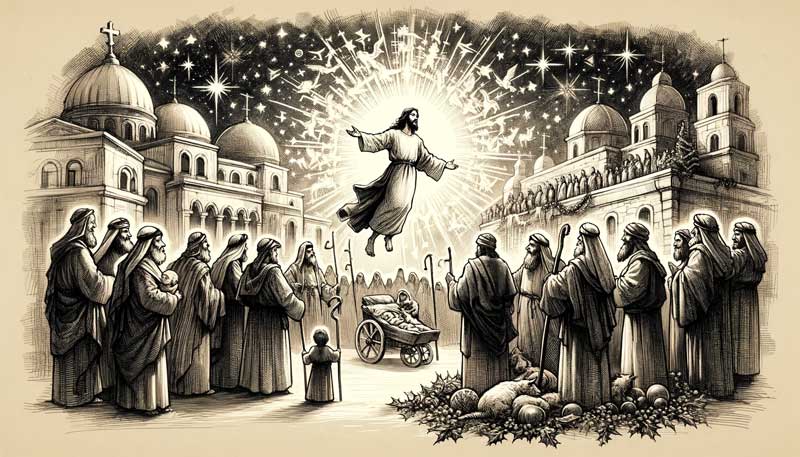Exploring the gospel accounts of Jesus’ birth offers a journey into narratives rich in history and meaning. Last year, I looked into the ‘Ancestral Family History: Ancestral Genealogy of Jesus,’ which sparked immense interest and discussion. I aim to build on that foundation this year with a fresh perspective.
Reflecting on last year’s post was a challenging yet enlightening endeavour. Sifting through textbooks, various Bible versions, and online sources to compile accurate information was not straightforward.
Choosing between different Gospels felt similar to gauging the wind’s direction – somewhat unpredictable. Ultimately, Matthew 1:1–17 guided me in revealing Jesus’ ancestry. Yet, this exploration left me yearning for more depth, hence my decision to compare two Gospels for a comprehensive narrative of Jesus’ birth.
My approach diverges from traditional analysis. Leveraging my qualitative and quantitative research background, I’ll compare Luke 1:26-2:40 and Matthew 1:18-2:23 in new ways. This involves examining themes, styles, contexts, and the frequency of specific words or themes. Such an analysis promises unique insights, stepping beyond conventional theological interpretations.
This exploration is about understanding the texts and uncovering their hidden stories and perspectives in the gospel accounts of Jesus’ birth. We can unearth subtleties often overlooked by analysing character development, setting, and plot.
Expect a journey through differing perspectives, a quest for understanding timings and locations, and deeper insights into narrative structures and socio-political contexts. Stay tuned as we unpack these narratives, offering a different lens to view the well-known stories of Jesus’ birth.

Choosing the Right Lens: Why I’m Using the NIV for This Exploration
In the exploration of the Gospels, the choice of Bible version is more than a matter of preference. The King James Version (KJV), published in 1611 under King James I, is revered for its poetic language. It’s a window into the past, reflecting centuries-old English. Yet, its beauty comes with complexity, often challenging to understand.
The New International Version (NIV), by contrast, emerged in 1978. Created by diverse scholars, it embodies a modern perspective critical for examining the gospel accounts of Jesus’ birth. This version translates ancient texts into language that resonates today. It’s built on the Nestle-Aland Greek manuscript, incorporating the latest scholarly findings. This modernity doesn’t just offer clarity; it connects us more directly with the narratives.
Choosing the NIV is about accessibility and comprehension. It bridges historical context with contemporary understanding, perfect for our in-depth journey through the nativity stories. This is our lens for an explicit, insightful exploration of the gospel accounts of Jesus’ birth.
Comparative Analysis of the Nativity Narratives in the Gospel Accounts of Jesus’ Birth
For this section of my insightful exploration, I will avoid the urge to simply recount the stories. I will aim to analyse them, uncovering the distinctive narrative styles. This comparative analysis aims to peel back the layers of these familiar accounts. Thus, offering a nuanced perspective on how each gospel portrays the nativity story.
Differing Perspectives in Matthew and Luke
The gospel accounts of Jesus’ birth in Matthew and Luke present contrasting yet complementary perspectives.
Matthew’s account, viewed through Joseph’s experiences, unfolds with a sense of urgency and divine direction. It’s a narrative enriched by dreams and angelic guidance. It is deeply rooted in fulfilling Old Testament prophecies and establishing Jesus’ messianic identity. Furthermore, this account illuminates the mystical elements that align Jesus’ birth with the long-anticipated hopes of the era.
Conversely, Luke’s narrative, centring on Mary, brings a detailed and human touch to the gospel accounts of Jesus’ birth. His story weaves through personal interactions, such as Mary’s visitation by Gabriel and her profound conversations with Elizabeth.
This approach combines the narrative with intimacy and warmth, offering a window into personal faith and divine grace. Additionally, including songs and praises in Luke’s account adds a lyrical and rejoicing dimension, capturing the joy and marvel surrounding Jesus’ arrival.

Intended Messages of the Accounts
In their respective gospel accounts of Jesus’ birth, Matthew and Luke target distinct audiences with tailored messages. Matthew’s narrative, resonating with Jewish traditions, centres on Joseph and intertwines Old Testament prophecies. This approach aligns Jesus’ story with Jewish messianic expectations. It seeks to convince Jewish readers of Jesus as the awaited Messiah.
Luke, writing primarily for Gentiles, offers an orderly, historical account. As the sole non-Jewish New Testament author, he highlights Jesus’ universal significance, setting the stage for a narrative beyond Jewish boundaries. Luke’s methodical style, as he mentions in the opening of his gospel, aims to provide a factual history of Jesus’ birth, enhancing its appeal and accessibility to a Gentile audience.
Thus, the gospel accounts of Jesus’ birth in Matthew and Luke serve dual purposes: Matthew’s narrative establishes Jesus within Jewish prophecy, while Luke’s rendition presents a comprehensive and verifiable story for a broader audience. These differing intents showcase each author’s strategic approach to narrating Jesus’ birth, offering us a multifaceted perspective on this pivotal event.
Complementary Aspects of the Narratives
We find a fuller, richer story by blending the gospel accounts of Jesus’ birth from Matthew and Luke. Both agree on crucial details: Jesus’ Bethlehem birth during Herod’s reign, Mary’s betrothal to Joseph, her virgin status, and the Holy Spirit’s role in conception. This consensus establishes a solid foundation for the birth narrative.
Matthew adds a political dimension, highlighting Herod’s perilous plans and the family’s subsequent flight to Egypt. This context is vital, revealing the immediate risks facing Jesus.
Luke, however, focuses on the personal side. He vividly describes Mary’s experience, the birth event, and its impact on figures like Elizabeth and the shepherds, infusing the narrative with human emotion and divine wonder.
Together, these accounts provide a comprehensive story. Matthew’s political insights and Luke’s intimate details merge, offering a historically grounded and deeply personal narrative. This synergy between the gospels paints a complete picture of Jesus’ birth, marrying historical facts with the story’s profound spiritual and communal resonance.

Exploring Key Questions and Variances in the Gospel Accounts of Jesus’ Birth
Continuing our in-depth analysis, we focus on the intriguing variances and pivotal questions within the gospel accounts of Jesus’ birth. This write-up segment seeks to show the complexities and contrasts between Matthew and Luke’s narratives.
We’ll examine the specific timing and locales of Jesus’ birth, the portrayals of angels and shepherds, the Magi’s significant visit, and the family’s crucial flight to Egypt. Additionally, we’ll compare the genealogies, shedding light on their distinct purposes. Each element we explore adds layers to our understanding, mixing to form a richer, more complete picture of these cherished biblical stories.
The Timing and Location of Birth
In the gospel accounts of Jesus’ birth, Matthew and Luke present distinct details regarding the timing and location. Luke specifies Jesus’ birth in Bethlehem during the census under Quirinius, placing it around 6-7 CE. This precise historical context highlights the Roman influence in Judea.
Matthew aligns with the Bethlehem location but sets the event during King Herod’s reign, suggesting a slightly earlier timeline.
These variations in the gospel account reflect different historical perspectives and converge on the significant detail of Bethlehem as the birthplace. This shared element fulfils the Messianic prophecy, showing the theological importance of Jesus’ origins.
The differing accounts, rather than conflicting, complement each other, offering a richer, more textured narrative of Jesus’ birth in the gospel accounts.
Angels and Shepherds in the Birth Narrative
Luke’s portrayal of angels and shepherds in the gospel accounts of Jesus’ birth is strikingly vivid, bringing a unique angle to the nativity story. Angels announcing the saviour’s arrival to shepherds symbolise a divine message shared with the humblest in society. This narrative choice by Luke adds a layer of inclusivity and universal joy to the birth story. This is the version we have become accustomed to today, portrayed in plays.
On the other hand, Matthew’s gospel doesn’t mention the shepherds or the angelic announcement. This absence is significant in its own right, aligning with his focus on other aspects of the narrative, such as the visit of the Magi.
The differences in Matthew and Luke’s gospel accounts of Jesus’ birth highlight varied perspectives. Luke’s inclusion of shepherds and angels adds to the richness of the nativity story, celebrating its universal and inclusive message. Matthew’s different focuses offer a complementary narrative, together giving a more complete view of the birth of Jesus.

The Magi’s Visit and the Flight to Egypt
In Matthew’s gospel accounts of Jesus’ birth, the Magi’s (the Three Wise Men, Three Kings, and the Three Magi) visit and the family’s flight to Egypt are pivotal elements.
This exclusive narrative in Matthew introduces the Magi, wise men led by a star to Jesus, symbolising his recognition as a universal king. Their gifts, rich in prophetic symbolism, emphasise the broader implications of Jesus’ birth.
In contrast, Luke’s gospel accounts of Jesus’ birth focus on the family’s return to Nazareth, bypassing the Magi’s visit and the flight to Egypt. This divergence in narratives highlights the authors’ distinct thematic focuses. While Luke centres on personal experiences and familial aspects, Matthew’s tale is of prophecy and divine intervention.
Matthew’s portrayal of the flight to Egypt, a detail absent in Luke, shows themes of divine protection and the fulfilment of Old Testament prophecies. This aspect, combined with the visit of the Magi, adds depth to our understanding of the gospel accounts, showcasing the multifaceted nature and universal significance of Jesus’ birth story.
Divergent Genealogies of Jesus
In the gospel accounts of Jesus’ birth, Matthew and Luke present contrasting genealogies, each with its unique narrative purpose. Matthew traces Jesus’ lineage through Joseph, linking him to Jewish patriarchs and King David, reinforcing his role as the prophesied Messiah. As detailed in my last year’s post, this comprehensive genealogy shows Jesus’ rightful place in Jewish history.
Luke, conversely in his gospel accounts of Jesus’ birth, traces Jesus’ ancestry through Mary, connecting him all the way back to Adam. This approach, emphasising Jesus’ universal humanity, aligns with Luke’s salvation theme.
In their distinct ways, both accounts contribute to a holistic understanding of Jesus’ lineage.

Deeper Insights into the Gospel Contexts of Jesus’ Birth
So that we can go deeper into the exploration of the nativity stories, we shift our focus to the broader dimensions that shape these narratives. In this section, we’ll dissect the intricate layers of narrative structure.
Explore the socio-political context, intended audience, and theological implications embedded in the gospel accounts of Jesus’ birth. The aim is to reveal these accounts’ complexities and profound meanings, offering a fresh, analytical perspective on the timeless stories in Matthew and Luke.
Narrative Structure
Matthew and Luke employ distinct narrative structures. Through Joseph’s lens, Matthew’s account strategically weaves in Old Testament prophecies. This appeals to Jewish readers, highlighting the fulfilment of these prophecies in Jesus’ birth.
This is exemplified when the Magi recognise Jesus as the King prophesied to come from Bethlehem, a moment echoing deep-rooted messianic predictions.
Luke’s narrative, centred around Mary, intricately arranges reactions and dialogues for dramatic impact, emphasising the Holy Spirit’s role. This approach, resonating with Gentiles, builds awe from Mary’s encounter with the divine to the shepherd’s amazement and Simeon’s revelation.
Luke draws on Old Testament stories, contributing to the Gospel accounts of Jesus’ birth with layers of awe and prophecy fulfilment.
Through their narrative structures, both Gospels emphasise Jesus as the fulfilment of Jewish messianic prophecies, each tailored to their respective audiences, adding rich dimensions to the gospel accounts of Jesus’ birth.

Socio-Political Context
Matthew’s account of Jesus’s birth in the Gospels examines the socio-political dynamics under King Herod’s reign, portraying Jesus’ entry into a world fraught with political threats. This approach resonates with a Jewish audience because it emphasises Jesus’ link to the lineage of King David against the backdrop of Roman rule.
Conversely, Luke’s narrative in the Gospel accounts of Jesus’ birth highlights Roman influences, such as the census under Quirinius’s governorship. Writing primarily for Gentiles, he weaves a broader socio-political context into the divine story, presenting Jesus as a universal saviour.
Through their distinct socio-political lenses, both narratives enrich our understanding of the historical and cultural setting that shaped the portrayal of these pivotal events in the Gospel accounts of Jesus’ birth.
Intended Audience
In the Gospel accounts of Jesus’ birth, Matthew’s gospel is intricately linked to Jewish heritage, using references and symbolism deeply entrenched in Jewish culture. This targeted approach affirms Jesus’ messianic role for Jewish readers and aligns with their understanding of religious prophecy.
Contrastingly, Luke’s account in the Gospel accounts of Jesus’ birth has a universal appeal, reaching out to a Gentile audience. He bridges cultural gaps by explaining Jewish customs and broadening Jesus’ ancestry, thus making the narrative more inclusive and accessible to non-Jewish readers.
Through their unique focus, each gospel writer shapes their narrative to engage their specific audience, profoundly impacting how the story of Jesus’ birth is presented and interpreted.
Theological Implications
In the Gospel accounts of Jesus’ birth, Matthew’s perspective emphasises Jesus as the prophesied Jewish Messiah, deeply entwined with Jewish heritage and prophecy. This portrayal reflects a theological understanding of Jesus fulfilling ancient prophecies, aligning closely with Jewish expectations of the Messiah.
However, Luke’s account in the Gospel accounts of Jesus’ birth presents a more universal view. His depiction of Jesus acknowledges the Jewish prophetic tradition and extends his significance to all humanity, including the marginalised.
Luke’s narrative suggests a theology of inclusivity and universal salvation, emphasising Jesus’ role as a compassionate saviour for all.
These accounts contribute to a multifaceted theological understanding of Jesus in Christian belief. Reflecting diverse perspectives on his nature and significance.

Reflecting on the Gospel Accounts of Jesus’ Birth: Concluding Thoughts
This analysis of the gospel accounts of Jesus’ birth in Matthew and Luke has illustrated their unique portrayals. Each has its distinct perspective and audience.
Matthew anchors his narrative in Jewish prophecy and heritage, presenting a Messiah deeply connected to Jewish expectations. Luke, alternatively, portrays Jesus’ universal significance, reaching beyond Jewish confines to embrace all of humanity.
Through this exploration, we’ve gained knowledge of differing accounts. And an appreciation for how these perspectives enrich our understanding of Jesus’ role and significance. These insights, grounded in qualitative analysis, invite us to appreciate the complex layers of these narratives in the Gospel accounts of Jesus’ birth. Allowing us to reflect on their relevance to our modern understanding of faith and identity.
The Gospels of Matthew and Luke offer more than historical accounts. They present a dynamic and living story, inviting ongoing engagement and interpretation. This analysis, rooted in a blend of storytelling and factual exploration, aims to contribute to that ongoing conversation in the gospel accounts of Jesus’ birth.
Sources
- Bible Gateway. Luke 1:26-2:40, Matthew 1:18-2:23. New International Version (NIV). [Accessed 19 December 2023]


